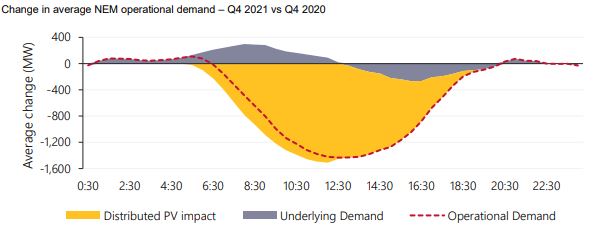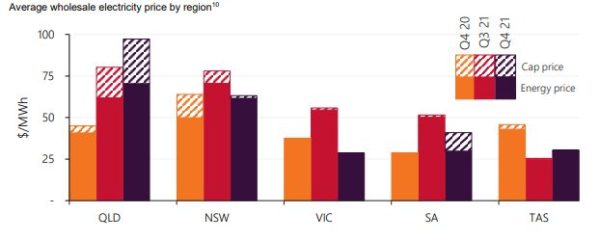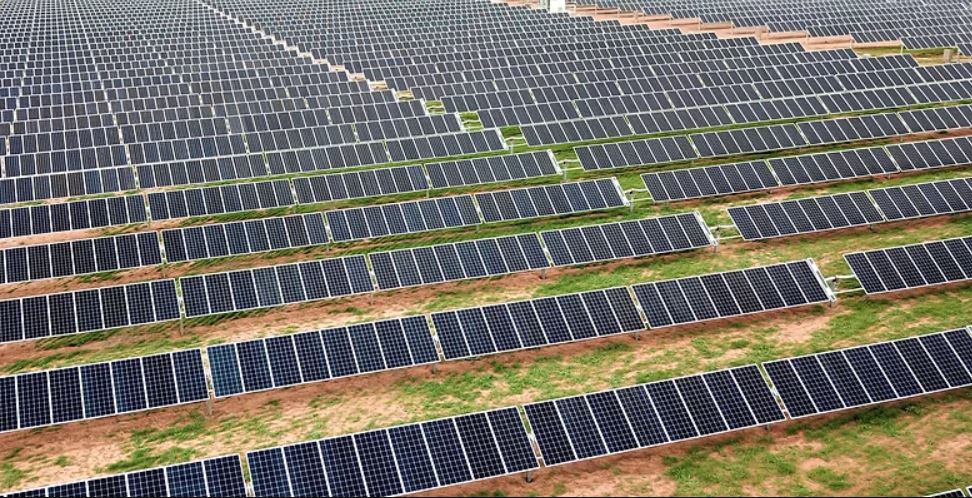The Australian Energy Market Operator’s (AEMO) latest Quarterly Energy Dynamics report reveals that renewables, including grid-scale wind and solar and distributed PV reached a 34.9% share of generation in the National Electricity Market (NEM) in Q4 2021.
AEMO said instantaneous renewable penetration achieved a new high of 61.8% in the December quarter, up marginally from 61.4% in the previous quarter while average renewable penetration levels for the quarter increased more significantly from 31.6% in Q3 2021 to 34.9%.
AEMO’s executive general manager of reform delivery, Violette Mouchaileh, said the record levels of renewables – including continued growth in grid-scale solar output which at 269 MW exceeded wind output growth of 156 MW – coupled with below-average temperatures contributed to new records for minimum operational demand in the NEM during the quarter.
New minimum operational demand records were seen in New South Wales (NSW) which dropped to 4,425 MW, down 211 MW on the previous minimum (4,636 MW) set in 1999, Victoria which declined 196 MW from 2,529 MW to 2,333 MW, and South Australia which dropped from 236 MW to 104 MW.

Image: AEMO
Minimum operational demand for the NEM as a whole fell to a record low of 12,936 MW, down 1,257 MW on the previous low set in Q3 2021. The quarterly average operational demand fell to 19,876 MW, its lowest Q4 average since 2005.
“Grid-scale solar, wind, hydro and rooftop solar PV continued to displace thermal generation, with black coal-fired generation falling to its lowest Q4 average since 1998, while gas generation declined to its lowest Q4 average since 2003,” Mouchaileh said.
Daytime electricity prices also continued to fall during the quarter, the first in which the NEM operated with five-minute settlement (5MS).
“The changing generation mix saw zero or negative spot prices occurring during 16.6% of all dispatch intervals during the quarter and a total of 11.2% for 2021, more than doubling 2020’s average of 4.9%,” Mouchaileh said.
NEM mainland electricity prices averaged $39 per MWh in October but reached $75 MWh by December, lifted by rising prices in Queensland with growing volatility in that state and in South Australia. For the quarter as a whole, mainland prices averaged $57 MWh, still below Q3’s average of $66 MWh but 31% higher than Q4 2020’s $44 MW.
“While underlying spot prices fell or were stable in the southern NEM regions, the larger share of thermal generation in Queensland and NSW and higher prices being set by black coal and gas, as well as limitations on transfers of lower cost energy from the southern regions, each contributed to an average $45 MWh north-south price differential,” Mouchaileh said.

Image: AEMO
Queensland’s price of $97 MWh was its highest Q4 average on record, more than double the level of one year ago, with price volatility in November and December lifting the region’s average by $27 MWh.
Conversely, Victoria’s quarterly average price of $28 MWh was its lowest Q4 average since 2014.
In Western Australia’s Wholesale Electricity Market (WEM), increasing levels of renewables met nearly 40% of total underlying demand in the quarter and established a new minimum operational demand record.
“Similar to the NEM, unabated rooftop solar PV investment set a new minimum operational demand record of 761 MW on 14 November 2021, a 12% decrease on the previous record. During this 30-minute interval, rooftop solar PV met 67% of the total underlying demand,” Mouchaileh said.
“Unlike the NEM, a four-day heat wave event in the WEM from Christmas Day set a new Q4 maximum operational demand record at 3,869 MW on 27 December, just 137 MW lower than the all-time maximum demand set in February 2016,” she said.
The increase in renewables also led to a 16% reduction in gas and distillate-powered generation.
This content is protected by copyright and may not be reused. If you want to cooperate with us and would like to reuse some of our content, please contact: editors@pv-magazine.com.









By submitting this form you agree to pv magazine using your data for the purposes of publishing your comment.
Your personal data will only be disclosed or otherwise transmitted to third parties for the purposes of spam filtering or if this is necessary for technical maintenance of the website. Any other transfer to third parties will not take place unless this is justified on the basis of applicable data protection regulations or if pv magazine is legally obliged to do so.
You may revoke this consent at any time with effect for the future, in which case your personal data will be deleted immediately. Otherwise, your data will be deleted if pv magazine has processed your request or the purpose of data storage is fulfilled.
Further information on data privacy can be found in our Data Protection Policy.